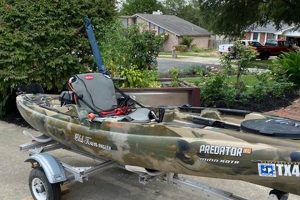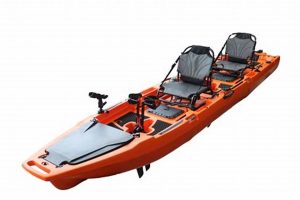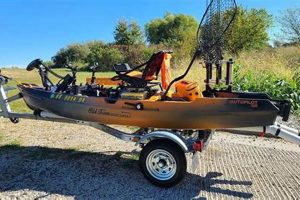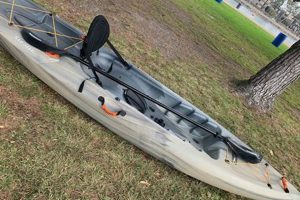High-quality angling kayaks manufactured by Jackson Kayak are frequently sought after by both novice and experienced anglers. These vessels are designed with specific features catering to the needs of fishing enthusiasts, such as rod holders, tackle storage, and comfortable seating arrangements. A used Jackson Kayak offers a potential avenue for acquiring these specialized features at a lower price point than purchasing new.
Acquiring a pre-owned fishing kayak from this reputable brand offers several advantages. It allows anglers to access premium design and construction at a reduced cost. The robust build of these kayaks ensures durability and longevity, making them a worthwhile investment even in the secondhand market. Historically, Jackson Kayak has been a leading innovator in fishing kayak design, contributing significantly to the evolution of the sport. A used model often incorporates these advancements, offering enhanced stability, maneuverability, and overall fishing performance.
This discussion will further explore key considerations for those seeking a pre-owned Jackson fishing kayak, including factors affecting pricing, assessing condition, identifying the appropriate model, and navigating the purchase process. Understanding these elements will help prospective buyers make informed decisions and acquire a vessel well-suited to their individual fishing needs and preferences.
Tips for Purchasing a Used Jackson Fishing Kayak
Acquiring a pre-owned Jackson fishing kayak presents an opportunity to obtain a high-quality vessel at a potentially reduced cost. Careful consideration of several factors will contribute to a successful purchase.
Tip 1: Research Specific Models: Jackson Kayak offers a diverse range of models, each designed with specific fishing styles and angler preferences in mind. Thorough research into the various models will help determine the most suitable option.
Tip 2: Assess Hull Condition: Examine the kayak’s hull for any signs of damage, such as deep scratches, cracks, or repairs. Minor superficial scratches are common, but significant damage could compromise performance and safety.
Tip 3: Inspect Seating and Hardware: Ensure the seat is comfortable and adjustable, and check all hardware components, including rod holders, hatches, and footrests, for proper functionality and security.
Tip 4: Verify Outfitting Completeness: Confirm that all essential outfitting components are present and in good working order. Missing or damaged parts might necessitate additional expenses.
Tip 5: Consider Storage Options: Evaluate the kayak’s storage capacity and layout. Ample storage space is crucial for carrying fishing gear and personal belongings.
Tip 6: Evaluate Pricing: Compare prices from various sellers to determine a fair market value for the chosen model and condition. Factors influencing price include age, condition, and included accessories.
Tip 7: Inquire About the Kayak’s History: If possible, gather information about the kayak’s usage history, including how often it was used and how it was stored. This information can provide valuable insights into its overall condition.
Tip 8: Conduct a Thorough Inspection in Person: Whenever feasible, inspect the kayak in person before making a purchase. This allows for a comprehensive assessment of its condition and features.
By following these guidelines, prospective buyers can increase their chances of acquiring a used Jackson fishing kayak that meets their specific needs and provides years of enjoyable angling experiences.
This careful evaluation process is essential for maximizing the benefits of purchasing a pre-owned kayak, ensuring a sound investment, and facilitating informed decision-making.
1. Model Selection
Model selection represents a critical stage in the process of acquiring a pre-owned Jackson fishing kayak. The diverse range of models available reflects varying design priorities, catering to specific fishing styles, body types, and water conditions. This diversity necessitates careful consideration of individual needs and preferences to ensure optimal performance and angler satisfaction. Selecting an inappropriate model could lead to discomfort, limited functionality, and a compromised fishing experience. For instance, an angler intending to fish in large open water environments would require a different model compared to someone fishing in small rivers or creeks. Similarly, an angler requiring significant storage capacity would prioritize models designed with ample storage compartments.
The practical significance of meticulous model selection becomes particularly apparent when considering the long-term investment a fishing kayak represents. Factors such as hull design (sit-on-top vs. sit-inside), length, width, and weight influence stability, maneuverability, and tracking performance. Examples include the Cruise, known for its stability and versatility; the Coosa, designed for river fishing and maneuverability; and the Big Tuna, built for tandem fishing and increased capacity. Understanding these distinctions allows for informed decisions aligned with the intended fishing application. Furthermore, model-specific features such as rod holders, tackle storage compartments, and seating systems contribute significantly to angler comfort and efficiency on the water.
In summary, successful acquisition of a used Jackson fishing kayak hinges on informed model selection. This process involves careful evaluation of individual needs, fishing styles, and intended water conditions, matched against the specific features and performance characteristics of available models. This careful consideration mitigates potential challenges arising from ill-suited equipment, ensuring a positive and productive fishing experience. Ultimately, thoughtful model selection maximizes the long-term value and enjoyment derived from a pre-owned Jackson fishing kayak.
2. Condition Assessment
Condition assessment plays a crucial role in the purchase of a pre-owned Jackson fishing kayak. The kayak’s condition directly impacts its functionality, safety, and value. A thorough assessment mitigates the risk of acquiring a vessel with hidden damage or excessive wear, potentially leading to costly repairs or a compromised fishing experience. For example, a kayak with a severely damaged hull might exhibit reduced buoyancy or stability, posing a safety risk. Similarly, worn-out seating or damaged hardware can compromise comfort and functionality, detracting from the overall fishing experience. Conversely, a well-maintained kayak in good condition offers reliable performance and potentially extends its lifespan, maximizing the value of the investment. Therefore, careful condition assessment is essential for informed decision-making.
Practical application of condition assessment involves a systematic evaluation of key components. This includes a detailed inspection of the hull for cracks, deep scratches, or repairs. Examination of the seating, hardware, and other outfitting components for wear and tear, proper functionality, and secure attachment is also critical. Furthermore, assessing the condition of any included accessories, such as paddles, rudders, or fish finders, contributes to a comprehensive understanding of the kayak’s overall value and readiness for use. For instance, a faded or cracked hull, corroded hardware, or a torn seat might indicate significant wear and tear, potentially impacting the kayak’s longevity and performance. Recognizing these signs allows prospective buyers to negotiate a fair price or consider alternative options.
In summary, condition assessment is an integral aspect of purchasing a used Jackson fishing kayak. It safeguards against unforeseen expenses and ensures the acquisition of a vessel suitable for its intended purpose. Meticulous evaluation of the kayak’s physical state allows for informed decisions, aligning the purchase with the buyer’s expectations and maximizing long-term satisfaction. Neglecting this critical step can lead to disappointment and potentially compromise safety. Therefore, a thorough condition assessment is paramount for a successful and rewarding purchase experience.
3. Pricing Evaluation
Pricing evaluation is paramount when considering a pre-owned Jackson fishing kayak. Market dynamics, condition, model, and included accessories influence pricing. A thorough evaluation prevents overpaying and ensures a sound investment. Discerning fair market value requires researching comparable listings, considering depreciation, and evaluating the kayak’s overall condition. For instance, a newer model in excellent condition with premium accessories will command a higher price than an older, well-used model with basic features. Failure to conduct thorough price research could lead to a purchase above market value, diminishing the investment’s potential return.
Practical application of pricing evaluation involves comparing listings from various sources, including online marketplaces, specialized retailers, and private sellers. Analyzing recent sales data for similar models provides a benchmark for assessing price reasonableness. Furthermore, considering regional market variations, seasonal demand fluctuations, and the urgency of the sale can provide valuable context. For example, kayaks might be priced higher during peak fishing season or in regions with high demand. Conversely, sellers might offer discounts for quick sales or during the off-season. Recognizing these factors empowers buyers to negotiate effectively and secure a fair price. Moreover, factoring in the potential cost of any necessary repairs or upgrades provides a comprehensive assessment of the total investment.
In summary, pricing evaluation is a critical aspect of acquiring a used Jackson fishing kayak. It safeguards against financial missteps and ensures a prudent investment. Objective analysis of market trends, condition assessment, and comparison shopping empower informed decision-making. This process contributes significantly to buyer confidence and maximizes the long-term value of the purchase. Neglecting this essential step can lead to financial regret and a diminished overall experience. Therefore, a comprehensive pricing evaluation is indispensable for a successful and rewarding purchase.
4. Seller Reputation
Seller reputation significantly influences the purchase process for pre-owned Jackson fishing kayaks. A reputable seller contributes to a secure transaction, accurate product representation, and reliable customer service. Conversely, a seller with a poor reputation can introduce risks, including misrepresented product condition, delayed shipping, or unresolved disputes. Understanding the components of seller reputation empowers informed decisions and mitigates potential issues.
- Feedback and Reviews
Online marketplaces and forums often feature seller feedback and reviews from previous buyers. These reviews provide valuable insights into seller responsiveness, communication, and the accuracy of product descriptions. Positive reviews indicate a history of reliable transactions, while negative reviews may signal potential issues. For instance, consistent positive feedback regarding accurate product descriptions and timely shipping builds trust and confidence in a seller offering a used Jackson fishing kayak. Conversely, multiple reports of misrepresented kayak conditions or unresponsive communication warrant caution.
- Seller Verification and History
Established online platforms often implement seller verification processes, adding a layer of security to transactions. Verified sellers typically undergo identity checks or meet specific criteria established by the platform. Furthermore, examining a seller’s history, including the duration of their presence on the platform and the number of successful transactions, contributes to assessing their reliability. A long-standing seller with a history of positive transactions generally presents a lower risk compared to a newly registered seller with limited history. This information provides valuable context when evaluating a potential purchase.
- Return Policy and Guarantees
Clear and comprehensive return policies and guarantees demonstrate seller accountability and commitment to customer satisfaction. These policies outline procedures for returns, refunds, or exchanges in case of discrepancies or defects. A seller offering a reasonable return policy for a used Jackson fishing kayak provides recourse for buyers if the received product does not match the description or arrives damaged. The absence of a return policy or unclear terms increases the risk of unresolved issues and potential financial loss.
- Communication and Responsiveness
Effective communication and prompt responsiveness are essential aspects of a positive buying experience. A reputable seller responds promptly to inquiries, provides accurate product information, and maintains clear communication throughout the transaction. For instance, a seller readily answering questions about a used Jackson fishing kayak’s condition, features, or shipping details indicates professionalism and transparency. Conversely, delayed responses, evasive answers, or a lack of communication can signal potential problems and erode buyer confidence.
By considering these facets of seller reputation, prospective buyers can mitigate risks and enhance their chances of a successful purchase. A reputable seller contributes significantly to a smooth, secure transaction and a positive overall experience when acquiring a pre-owned Jackson fishing kayak. Neglecting to assess seller reputation can expose buyers to potential issues and diminish the enjoyment of their new acquisition.
5. Purchase Process
The purchase process for a pre-owned Jackson fishing kayak significantly impacts the buyer’s experience and the transaction’s overall success. A well-defined process ensures a secure transaction, protects buyer interests, and facilitates efficient transfer of ownership. Conversely, a poorly managed process can introduce risks, including fraud, miscommunication, and logistical challenges. Understanding the key elements of a secure and efficient purchase process is essential for both buyers and sellers. For instance, a clearly defined payment method, such as a secure escrow service or a reputable payment platform, protects both parties from potential fraud. Similarly, established procedures for shipping or local pickup minimize logistical complications and ensure timely delivery.
Practical application of a robust purchase process involves several key steps. Firstly, communication between buyer and seller establishes clear expectations regarding payment methods, shipping arrangements, and any warranties or guarantees. Secondly, a secure payment method protects financial interests and provides recourse in case of disputes. Examples include escrow services, which hold funds until both parties fulfill their obligations, or established online payment platforms offering buyer protection. Thirdly, documented agreements outlining the terms of the sale, including the kayak’s condition, price, and any included accessories, protect both parties and provide a reference point in case of discrepancies. Finally, a reliable shipping method with tracking information ensures safe and timely delivery of the kayak. For local pickups, a designated meeting place and a clear exchange process contribute to a smooth transaction. Neglecting these steps can lead to misunderstandings, delays, and potential financial losses.
In summary, a well-defined purchase process is crucial for acquiring a pre-owned Jackson fishing kayak. It safeguards against potential risks, facilitates efficient transactions, and contributes to a positive buying experience. Careful consideration of payment methods, shipping arrangements, and documented agreements protects both buyer and seller interests. This process ensures a smooth transfer of ownership and minimizes potential complications. Ultimately, a robust purchase process contributes significantly to the satisfaction and confidence of all parties involved.
Frequently Asked Questions
This FAQ section addresses common inquiries regarding the acquisition of pre-owned Jackson fishing kayaks. Clear and concise answers provide prospective buyers with essential information to navigate the purchase process effectively.
Question 1: What factors influence the price of a used Jackson fishing kayak?
Factors affecting price include the kayak’s model, age, condition, included accessories, and current market demand. Newer models in excellent condition with premium features typically command higher prices.
Question 2: Where can one find used Jackson fishing kayaks for sale?
Potential sources include online marketplaces, specialized retailers, classified ads, and local paddling communities. Each source offers distinct advantages and disadvantages regarding selection, pricing, and convenience.
Question 3: How can one assess the condition of a used fishing kayak?
Thorough inspection should encompass the hull, seating, hardware, and any included accessories. Checking for cracks, scratches, wear, and proper functionality is essential. If possible, in-person inspection is recommended.
Question 4: What are the essential accessories to consider when purchasing a used fishing kayak?
Essential accessories may include paddles, personal flotation devices (PFDs), rod holders, and storage solutions. The specific requirements depend on individual fishing styles and preferences.
Question 5: What are the benefits of purchasing a used Jackson fishing kayak?
Primary benefits include cost savings compared to new models, access to discontinued models, and the potential for acquiring premium features at a reduced price. Thorough research and condition assessment are crucial for maximizing these benefits.
Question 6: What precautions should be taken when purchasing a used kayak from a private seller?
Precautions include verifying the seller’s identity, using secure payment methods, documenting the agreement in writing, and conducting transactions in safe, public locations when possible.
Understanding these key aspects empowers prospective buyers to navigate the purchase process effectively and acquire a used Jackson fishing kayak that aligns with individual needs and preferences. Careful consideration of these factors contributes to a successful and rewarding purchase experience.
Further research into specific models, features, and regional market conditions is recommended to optimize the purchase decision.
Conclusion
Acquiring a pre-owned Jackson fishing kayak presents a viable pathway to owning a high-quality vessel tailored for angling. Careful consideration of model selection, condition assessment, pricing evaluation, seller reputation, and a secure purchase process are essential for a successful acquisition. These factors contribute significantly to maximizing value and ensuring long-term satisfaction with the investment. Understanding these elements empowers informed decision-making, aligning the purchase with individual angling needs and budgetary considerations.
The pursuit of a pre-owned Jackson fishing kayak represents more than just acquiring a vessel; it represents an investment in enhanced fishing experiences. Diligent research and a thorough evaluation process are crucial for realizing the full potential of this investment. By prioritizing these considerations, anglers can confidently navigate the pre-owned market and acquire a kayak well-suited to their specific needs and aspirations, ultimately enhancing their time on the water.






